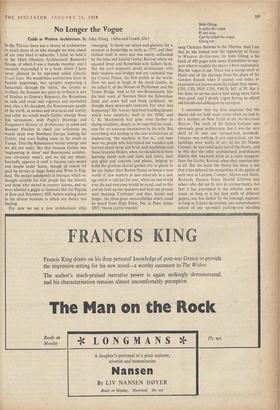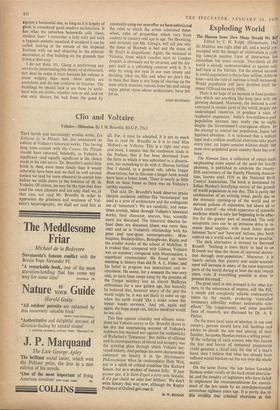No Longer the Vogue
Guide to Western Architecture. By John Gloag. (Allen and Unwin, 63s.) IN the Thirties there was a theory of architecture to which those of us who thought we were ahead of our time liked to subscribe. I think we held it in the Mars (Modern Architectural Research) Group, of which I was a founder member, and I certainly expounded it in a book which I have never allowed to be reprinted called Ghastly Good Taste. We would trace architecture from its humble beginnings, two uprights supporting a horizontal, through the 'styles,' the Greeks so civilised, the Romans not quite so civilised (a sort of Pimlico to Greece's Regency), the Byzantines so rude and crude and vigorous and sun-baked and, alas, a bit decadent, the Romanesque people of the north, so serious and structural and worthy and solid; we would watch Gothic 'emerge' from this seriousness; with Pugin's drawings and Fergusson's History of Architecture in mind and Banister Fletcher to check our references we would skate over Northern Europe looking for Gothic, and even finding some as far south as Venice. Then the Renaissance would 'emerge' and we did not really like that because Gothic was 'engineering in 'stone' and Renaissance architec- ture obviously wasn't, and we did not whole- heartedly approve it until it became very severe and simple under Soane, though Of course we paid lip service to Inigo Jones and Wren in Eng- 'land. We smiled indulgently at baroque which we thought suitable for rich people like the Sitwells and those who stayed in country houses, and we even allowed a giggle at fantasies like the Pagoda at Kew and Strawberry Hill, before settling down to the serious business to which our theory was leading.
For now we see a new architectonic ethic
'emerging.' It stood out naked and glorious for a moment at Ironbridge as early as 1777, and then clothed itself in stone and was nearly suffocated by the false and hateful Gothic Revival where we equated Street and Butterfield with Gilbert Scott. But the civil engineers saved architecture with their viaducts and bridges and our cathedral was the Crystal Palace, the first prefab in the world. How we used to laugh at the mock-Gothic, as we called it, of the Houses of Parliament and the Tower Bridge. And as for neo-Renaissance, like the later work of Norman Shaw the Edwardian hotel and town hall and bank architects, we thought them downright immoral. For what was happening? Mr. Voysey had been building houses which were simplicity itself in the 1890s, and C. R, Mackintosh had gone even farther in daring simplicity, deeply as we regretted his weak- ness for art nouveau decorations by his wife. But everything was leading to the new architecture of engineering, 'the machine to live in,' and here were we, people who had missed our vocation and learned about stone and brick and mouldings and those tiresome Orders, when we should have been learning about nuts and bolts and rivets, steel and glass and concrete and plastic, helping to build the glorious eternal garden city to gleam in the sky higher than Boston Stump to house a new world of new workers in new materials in a new age which would last for ever, where no one would ever die and everyone would be equal, and to this end we took up our spanners and beat our pressed steel shouting 'Corbusier' and then, louder and longer, the three great monosyllables which could be heard from High Point, N6, to Peter Jones, SW7, 'FRANK LLOYD WRIGHT.'
John Gloag Is quite the vogue
If any man
Can be called the vogue Gloag can
sang Christian Barman in the Thirties. And I see that he has looked over the typescript of Guide to Western Architecture, by John Gloag, a fat book of 400 pages with many illustrations to sup- port what is roughly the theory I have expounded. But the vogue is out. There was a strong smell of Heals and of the shavings from the plane of Sir Gordon Russell when it started, and today its exponents are known more by initials than name : COI, CID, PEP, LDS, FRCO, MT of PI. But it has done its service and is now doing more harm than good, and I deeply regret having to offend old friends and colleagues by saying so.
I remember that my first suspicion that the theory did not hold water came when we had to do a number on New Delhi in the Architectural Review. The work of Sir Edwin Lutyens was obviously great architecture, but it was the very devil to fit into our nut-and bolt standards. Lutyens was nothing. if not unpractical, • yet his buildings were works of art. As for Sir Ninian Comper, he was ruled quite out of the theory, and to this day the older architectural pontificators dismiss this wayward artist as a mere hangover from the Gothic Revival, when they mention him at all. But the harm the theory has done is not that it has delayed the recognition of the genius of such men as Lutyens, Comper, Mewes and Davis, Rickards, Eustace Frere, Harold Gibbons and others who did not fit into its compartments, but that it has percolated to the suburbs, and any room, so long as it has four walls of different papers, any bus shelter by the borough engineer, so long as it lacks decoration, any comprehensive school of one up-ended packing-case standing
against a horizontal one, so long as it is largely of glass, is considered good modern architecture. It has what the suburban housewife calls 'clean, modern lines.' I remember a lady with just such a hygienic msthetic standard, if standard it can be called, looking at the outside of the Imperial Institute with me and objecting to the exterior decoration of that building on the grounds that it was a 'dust trap.'
I do not think Mr. Gloag is performing any service by perpetuating this theory of architecture, nor does he make it truer because his volume is more weighty than most. - Most artists are anarchists and do not conforrn to theories. The buildings we should look at are those by archi- tects who are artists, whether new or old, and we ' can only discern the bad from the good by constantly using our eyes after we have assimilated the rules to which the artists submitted them- selves, rules of proportion which vary from country to country and age to age. No theorising, and certainly not Mr. Gloag's, will tell you why the dome of Harrods is bad and the dome of St. Paul's is magnificent. Again, the terminal at Victoria, from which coaches start to London Airpdrt, is obviously not by an artist, and the Air- port itself is a refreshing contrast with it. It is only by using our eyes in our own streets and deciding what we like and what we don't like in them that there is any hope of clearing up the mess which theorists, remote from life and taking vague global views about architecture, have left for us.
JOHN BETJEMAN



































 Previous page
Previous page